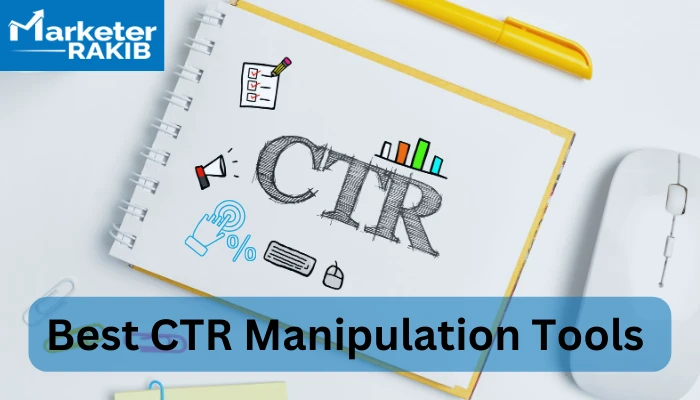Achieve Competitive Edge Online with Innovative LinkDaddy CTR Manipulation Methods
Achieve Competitive Edge Online with Innovative LinkDaddy CTR Manipulation Methods
Blog Article
Increasing Sales Through Strategic CTR Manipulation
In the affordable landscape of digital advertising, understanding the nuances of click-through prices (CTR) is crucial for driving sales. Strategic manipulation of CTR can lead to enhanced individual involvement and conversion rates, eventually profiting the lower line.
Recognizing Click-Through Price
 Click-through price (CTR) works as a crucial metric in reviewing the efficiency of digital advertising and marketing projects. It represents the proportion of individuals that click on a particular web link to the overall variety of individuals who view a email, advertisement, or webpage . Revealed as a percentage, CTR supplies important understandings into target market involvement and the significance of the content being promoted.
Click-through price (CTR) works as a crucial metric in reviewing the efficiency of digital advertising and marketing projects. It represents the proportion of individuals that click on a particular web link to the overall variety of individuals who view a email, advertisement, or webpage . Revealed as a percentage, CTR supplies important understandings into target market involvement and the significance of the content being promoted.A high CTR indicates that the material resonates well with the target audience, prompting them to act. Alternatively, a low CTR might signal that the project is misaligned with customer expectations or that the call to action is inefficient. A number of aspects can affect CTR, including the top quality of the ad copy, the appearance of visuals, and the positioning of links within the material.
By evaluating CTR data, services can recognize which approaches are functioning and which require modification. As a fundamental statistics, CTR plays a crucial function in the iterative process of digital advertising and marketing, paving the way for extra reliable techniques and better engagement with potential consumers.
Significance of CTR in Sales
A strong click-through rate straight correlates with sales performance, highlighting its value in the sales channel. CTR acts as a crucial sign of exactly how effectively an advertising and marketing campaign transforms prospective customers' passion into workable steps. A high CTR indicates that your audience discovers your messaging compelling, which is essential for driving website traffic to your sales pages.
Furthermore, a raised CTR can improve brand presence and authority. When potential customers involve with your emails or ads, it fosters an impact of depend on and relevance, developing your brand name as a best solution in the market. This can cause enhanced client loyalty and repeat purchases, further boosting sales figures.
In addition, a robust CTR can positively affect online search engine rankings and ad positioning costs. Higher engagement prices signify to online search engine and advertising and marketing systems that your content is valuable, permitting you to profit from better positioning and possibly lower costs for clicks.
Methods for Efficient CTR Adjustment
Efficient control of click-through rates (CTR) includes a strategic mix of compelling material, targeted target market engagement, and data-driven optimization methods. A well-structured headline not just ignites passion but also urges customers to click with.
Following, utilizing premium visuals can even more improve CTR. Additionally, using convincing and clear calls-to-action (CTAs) can guide users toward the preferred action.
 Segmenting your target market is another vital strategy. CTR Manipulation Service. Tailoring web content and offers to particular demographics makes certain that the messaging reverberates a lot more deeply, raising the likelihood of clicks. A/B screening various components, such as photos, ctas, and headings, additionally gives beneficial understandings into what drives greater CTR
Segmenting your target market is another vital strategy. CTR Manipulation Service. Tailoring web content and offers to particular demographics makes certain that the messaging reverberates a lot more deeply, raising the likelihood of clicks. A/B screening various components, such as photos, ctas, and headings, additionally gives beneficial understandings into what drives greater CTRStudying User Behavior
Understanding user actions is important for optimizing click-through prices and boosting general advertising and marketing strategies. By examining how users interact with web content, marketing experts can recognize patterns, preferences, and Source pain factors that substantially influence engagement. This evaluation involves examining metrics such as time invested on page, scrolling actions, and click pathways to determine what resonates with the target market.
Division is vital in recognizing individual behavior, as various demographics exhibit one-of-a-kind tendencies. For instance, more youthful users may move towards visually abundant web content, whereas older audiences might choose simple and clear messaging. A/B testing can additionally refine insights by contrasting variations in style, messaging, and call-to-action components, enabling online marketers to determine which alternatives yield higher involvement prices.
Additionally, checking customer responses via surveys and social networks can offer qualitative information that enriches quantitative findings. Recognizing the psychological triggers that drive user decisions is similarly important; leveraging this understanding makes it possible for the development of engaging material that urges clicks.
 Inevitably, a detailed analysis of customer habits not only help in boosting click-through prices however also notifies broader marketing strategies, making certain that campaigns are customized to satisfy the evolving needs of the audience.
Inevitably, a detailed analysis of customer habits not only help in boosting click-through prices however also notifies broader marketing strategies, making certain that campaigns are customized to satisfy the evolving needs of the audience.Determining CTR Success
Measuring the success of click-through prices (CTR) requires an organized strategy that improves insights gained from individual behavior analysis. To effectively determine CTR performance, organizations need to develop clear goals that straighten with their total advertising objectives. This framework enables companies to track development gradually and make informed changes.
Key efficiency indications (KPIs) should be defined, consisting of target CTR percentages based upon market standards. Regular monitoring of these metrics is essential, as it enables the recognition of anomalies and patterns. By segmenting information according to demographics, device kinds, and involvement levels, organizations can identify which sectors carry out best and tailor their methods accordingly.
A/B testing presents an additional valuable tool in measuring CTR success. By try out different advertisement formats, headlines, and calls to action, companies can determine one of the most effective combinations that resonate with their target audience. Evaluating the correlation between CTR and conversion prices gives much deeper insights into the efficiency of advertising initiatives.
Inevitably, a comprehensive strategy to gauging CTR success not just improves campaign performance however also notifies future strategies, driving continual organization development and improved client interaction.
Verdict
Finally, strategic site adjustment of click-through rates (CTR) works as an essential part in improving sales performance. By implementing reliable methods such as compelling headlines, top quality visuals, and targeted messaging, businesses can dramatically enhance user involvement and drive conversions. Moreover, continuous evaluation of individual actions and measurement of CTR success help with ongoing optimization of advertising and marketing strategies. Inevitably, a concentrate on CTR not just increases instant sales yet also adds to long-term my sources consumer loyalty and brand authority.
Strategic adjustment of CTR can lead to enhanced individual involvement and conversion rates, ultimately profiting the lower line. Alternatively, a low CTR might signify that the project is misaligned with individual assumptions or that the call to action is inadequate.Efficient control of click-through prices (CTR) entails a tactical blend of compelling material, targeted target market involvement, and data-driven optimization methods.Measuring the success of click-through rates (CTR) needs an organized strategy that constructs on understandings gained from user behavior analysis. Continuous analysis of customer behavior and measurement of CTR success facilitate ongoing optimization of marketing strategies.
Report this page